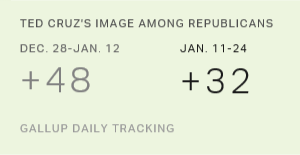Hillary Clinton's favorable ratings -- registering at 41% among national adults in September, and tying other recent lows -- have weakened, though it remains to be seen if fatally. Clinton, a candidate who at one time seemed like the most formidable in the field given her universal name recognition and high level of popularity, has suffered a fall in support over the last several months as her campaign continues to weather the fallout from her email practices as secretary of state. However, the decline in support has not been evenly felt across different population groups. In particular, Clinton's favorable rating with women has remained relatively stable, while it has declined with men.
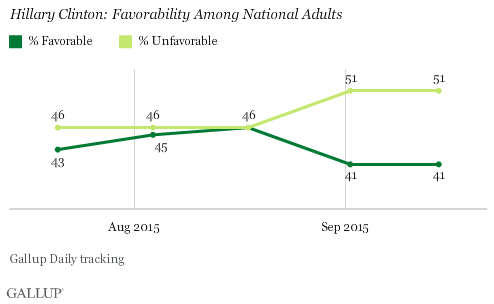
Looking at women first, it's clear that Clinton's current standing with women is greatly diminished from the favorable ratings she received as secretary of state (a position she served until February 2013) and throughout 2013. Her current favorable rating among U.S. women for the most recent two-week rolling average (Sept. 3-15) is 49%, with a lesser 43% saying they have an unfavorable rating of Clinton. By comparison, in May 2012, when Clinton's overall favorable rating reached a high of 66%, over seven in 10 women said they had a favorable view of Clinton. But since July 8, when Gallup began asking about Clinton's favorability on a daily basis, her support among women has remained relatively stable, even as the controversy over her email use as secretary of state has increasingly come to define her in the eyes of many Americans.
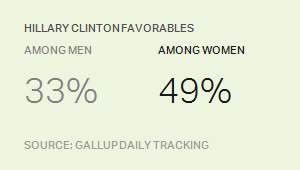
On any account, Clinton's favorable rating among women has shown no obvious signs of swift downward movement over the past two months, and throughout the period she has remained more popular with women than not.
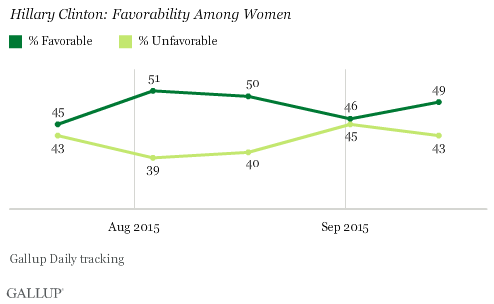
The more dramatic shift in Clinton's support has occurred among U.S. men, admittedly a group that was never particularly known to strongly favor Clinton. As seen in the two-week average for polling conducted July 8-21, Clinton was mildly unpopular among men -- her favorable rating with this group, at 42%, was surpassed by her unfavorable rating (49%). By the first two weeks of September, her favorable rating showed significant drops: A third of men viewed her favorably, compared with 59% unfavorably. It is the precipitous decline of her popularity with men, not women, that is driving down Clinton's overall image.
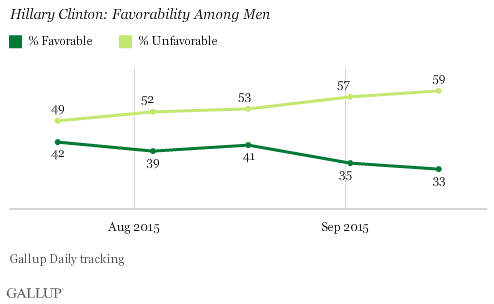
Of course, Clinton's main aim at the moment is winning the Democratic nomination, so it may seem premature to scrutinize her favorable rating among national adults. The good news for Clinton is that among women who identify as Democrats or as Democratic-leaning, Clinton's image remains in very good shape. In interviewing conducted Sept. 3-15, over three-fourths of Democratic women said they have a favorable image of Clinton (76%), while about a fifth (19%) said they view her unfavorably. These figures are broadly representative of typical ratings she has received since July 8.
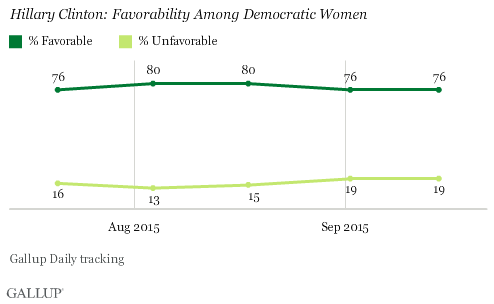
Support among men who identify with or lean toward the Democratic Party has remained relatively stable over the roughly two-month period, save for a notable recent drop. After hovering around 71% to 74% for July and August, Clinton's favorable rating with this group dropped to 64% for interviews conducted Sept. 3-15. While there is no doubt that this drop, if sustained, would be significant and potentially beneficial to a current or prospective Clinton challenger, it remains to be seen if this one swing in the data represents a long-lasting attitudinal change among Democratic men.
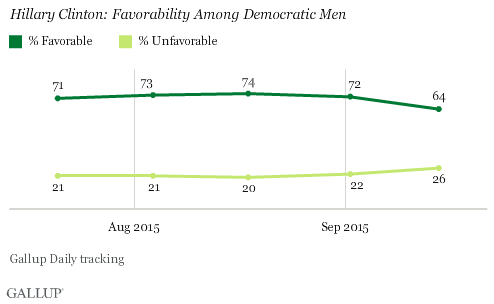
The takeaway is that Clinton's falling favorability has complicated her standing with men more so than with women. Clinton continues to enjoy an overall positive net favorability among women in general, and an extremely positive net favorability among Democratic women. As she looks to weather the political storm brought about by the so-called "email gate," Clinton may hope to draw on this well of support.
